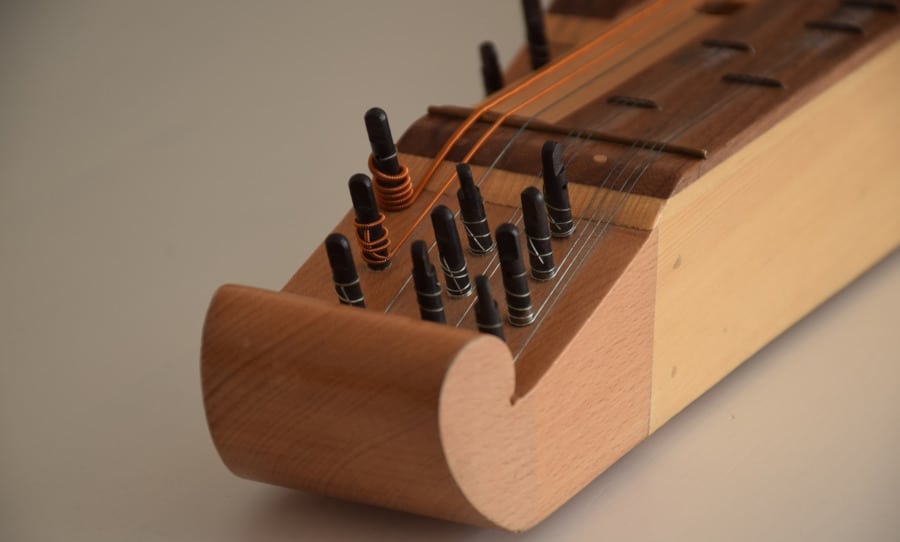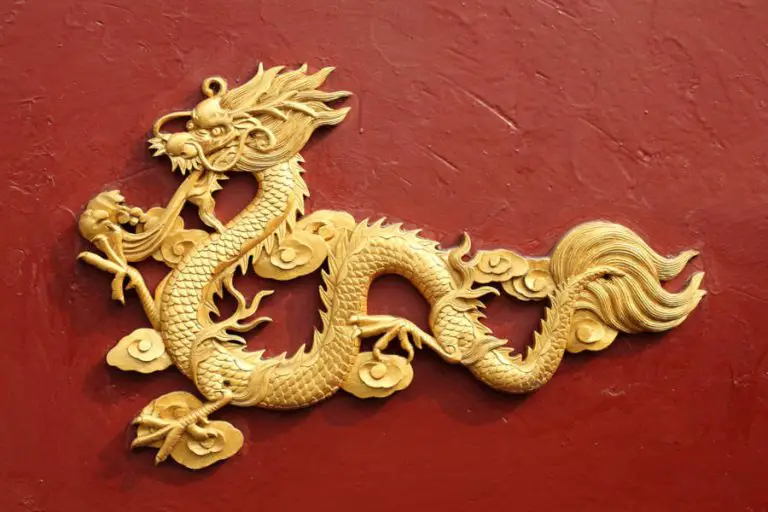Music has been a very important part of Chinese history and tradition. Even today, Chinese music still has that distinct characteristic that isn’t found anywhere else, mainly due to the unique sound of the traditional Chinese string instruments.
Below, we will discuss some of the most popular Chinese string instruments that have been passed from generation to generation.
1. Erhu
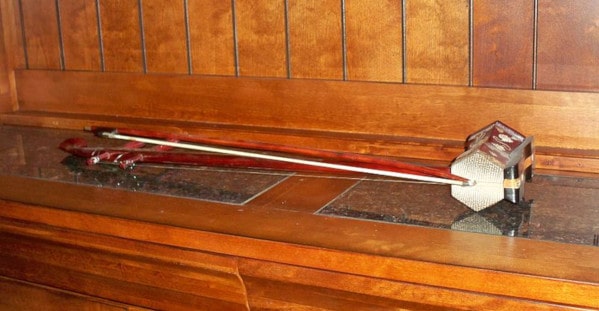
Erhu is one of the oldest Chinese string instruments, and we can argue that Erhu is one of the most important and popular musical instruments of China: the sound of ancient China itself.
One of the most unique qualities of Erhu is the fact that it only has two strings, but even with only this very limited number of strings, professional Erhu players can convey a lot of emotions with their play. Erhu is actually a very versatile and expressive bowed string instrument that can imitate neighing horses, chirping birds, and even human singing voices.
Despite its popularity, however, there are very few historical records surrounding the Erhu. The general consensus is that Erhu is an adaptation of Xiqin, an instrument that was introduced into central China by minority tribes during the times of the Tang dynasty (618-906 CE).
Also, Erhu was used very differently as a part of the Ancient Chinese musical composition back then, the sound of the “modern” Erhu that we know today is actually less than 100 years old, only introduced in 1915 when Liu Tianhua composed the first solo composition of Erhu, �The Sound of Agony’.
Erhu is widely known as the “Chinese violin, but there are many significant differences between the Erhu and the western violin. For instance, it is played on the musician’s lap (or on a table) vertically. It has no fingerboard, and the bow is already fixed between the two strings (not a separate part of the instrument.
It is technically an alto string instrument with middle-high range, known for producing the tender and somber sound that is often known as the sound of China. Click to see some Erhu models
Click to see some Erhu models – Opens in new tab.
2. Guzheng
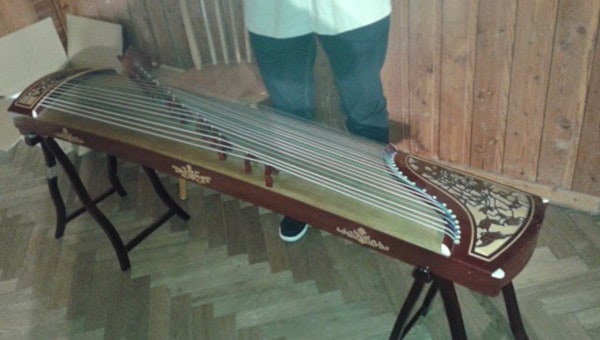
The name Guzheng consists of two Chinese characters: 古 (Gǔ) which means ancient, and 筝 (zhēng), which can be translated as zither. Guzheng is often translated incorrectly as zither. So, although when people mention zither nowadays it’s almost always referring to the Guzheng, zither is actually a category that includes many different string instruments.
The modern Guzheng we have today is actually a product of the 1960s—so it’s very new. However, the history of the ancient zither (or zheng) date from 6th century BCE in ancient China, so we have more than 2,600 years of history. Fragments of zithers were discovered and dated to the late Warring States period, so we know there were zithers between 475 and 221 BCE.
Related reading: “6 Traditional Chinese Wind Instruments (History and Facts)“
The Guzheng we have today was introduced (and patented) by the brand Dūnhuáng (�煌) back in 1865. They added the number of strings to 21 from the popular 16, so it can cover four octaves now, and now we have modern materials for the strings and the new S-shaped bridge.
Guzheng is a very complex instrument with a lot of strings, notes, and varying available styles to play it. Similar to Erhu, modern Guzheng music and play styles have also evolved dramatically. Guzheng is a really complex instrument with a lot of strings and can be played with various different play styles. There are so many techniques involved in playing the guzheng, not only picking of plucking the strings. A very versatile and beautiful Chinese string instrument.
Click to see some Guzheng models – Opens in new tab.
3. Guqin
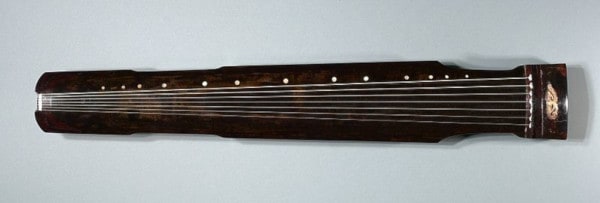
Out of all the traditional musical instruments from ancient China, Guqin is one with the most well-documented history, and there are also a lot of well-preserved ancient repertoires we still can access today.
Guqin is the favorite instrument for sages and scholars of ancient China. The great Confucius (551-479 BCE), for example, was recorded as a great master of this instrument, as well as the famous Ji Kong (223-262 CE).
The name Guqin comes from 古 (Gǔ), and 琴 (Qin). Gu, as we have established when we discussed Guzheng above, means ancient, and Qin means Chinese plucked seven-string instrument. Qin is actually a part of ancient China’s four arts of scholarship, four highly regarded artistic and academic accomplishments. So, Guqin is highly regarded as one of the important symbols of Chinese culture.
Since 2003, Guqin has been included by UNESCO in the Representative List of the Intangible Cultural Heritage of Humanity, showing its importance as a historic musical instrument.
Click to see some Guqin models – Opens in new tab.
4. Pipa
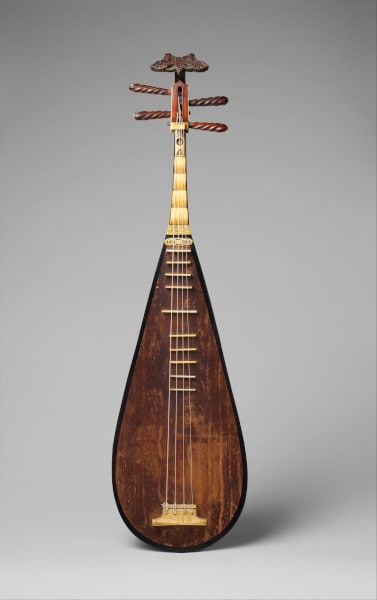
Pipa is—according to the historical records—, based on the Persian lute (Barbat), which was called Hu-pipa by the Chinese back then. The Barbat was brought to China through the Silk Road around the 5th century CE but didn’t become really popular until the 7th century, around the beginning of the Tang Dynasty.
Chinese musicians then modified the Hu-pipa into something called the Tang pipa. This is when the sound body was modified from being round to the pear-shaped body we have today, along with the bent neck, which used to be straight.
These modifications were done because the Hu-pipa didn’t really produce the proper sound to play Chinese songs like how the Chinese people back then used to. The
The modern Pipa was produced from further modifications from the Tang-pipa, with a crooked neck, 24-26 frets, and ledges that allow for its “bendable” slides, the signature romantic voice. The lower frets are made from bamboo, while the upper frets and tuning pegs are made of wood, ivory, or buffalo horns.
Pipa is still a very popular instrument today, and we can see it in various traditional Chinese entertainments like operas or traditional Chinese singing.
Click to see some Pipa models – Opens in new tab.
5. Yueqin

The name Yueqin literally means “moon-shaped string instruments”, with 月 (yuè) means moon and qín, as established above, is a generic term for string instruments.
Historians believed that the Yueqin has existed during the times of the Jin dynasty (265-420 CE), and is widely regarded as an integral part of China’s history. As the name suggests, the body is round-shaped resembling the moon, made entirely with wood materials and features a round hole in the middle (like an acoustic guitar).
Yueqin only features four strings that are attached directly to the frame of the sound body. In the past, the strings were made of silk threads but today they are made of steel or nylon, like most modern string instruments. The four strings are tuned in pairs, a fifth apart from each other, enclosing a vibrating plate.
The Yueqin, unfortunately, has not been fully adopted by modern Chinese orchestra, although it used to be really popular during the times of the Beijing opera during the Qing dynasty (18th century).
Also, Yueqin is very similar to Ruan, where both have a moon-shaped body. We will discuss the difference as we discuss Ruan below.
Click to see some Yueqin models – Opens in new tab.
6. Ruan

Ruan is one of the oldest ancient Chinese instruments with more than 2,000 years of history. As we have mentioned above, the Ruan has a similar round shape as the Yueqin, but the main difference is that the Ruan features the double soundholes, which is the reason of Ruan’s signature, lower-range sound, while the Yangqin only has one soundhole.
The instrument was originally called qin pipa (so, a modification of the Hu-pipa as discussed above), and it received the present name after the famous Ruan Xian (3rd century CE). Ruan became a popular string instrument by the time of the Tang dynasty (618-907 AD).
The Ruan has four strings and the modern frets are set in equal positions so players can easily modulate to any different key. The modern Ruan comes in several sizes from the Di Ruan (bass), Xiao Ruan (small), Zhong Ruan (medium), Da Ruan (large), and Gaoyin Ruan (soprano). Each of them offers a few different tunings.
Related reading: “4 Traditional Chinese Percussion Instruments: History, and Facts (Video)“
Click to see some Ruan models – Opens in new tab.
7. Yangqin

Yangqin is the most unique out of all the Chinese string instruments in this list for several reasons. First, it is undoubtedly the most mysterious. The Yangqin is a derivation of the Iranian Santur, and there are at least three different theories that tried to explain how the instrument was brought to China:
- Through the Silk Road
- Through the port of Guangzhou by sea
- It is invented by the ancient Chinese themselves without any foreign influence
Until today, there’s no general consensus of how the instrument was introduced to China.
The modern Yangqin usually has 144 strings, so it is an extremely complex instrument with four to five bridges. Players are supposed to strike the strings on the left side of the bridge. The Yangqin is a chromatic instrument (operates on a twelve-note chromatic scale instead of seven-notes diatonic scale), with a range of more than four octaves.
Until today, the Yangqin is still a popular member of the traditional Chinese orchestras and ensembles.
Click to see some Yangqin models – Opens in new tab.
End Words
String instruments are an integral part of the Chinese tradition and history, and some of the ones we have discussed here have existed for more than a thousand years.
There are actually a lot more string instruments from China than the ones available on this list. However, the ones above are arguably the most famous and the most important to Chinese history and tradition.
An Introduction to Chinese History & Culture (Aff.link)
Dive into China’s rich past and intriguing present! From ancient dynasties to modern powerhouses, uncover Chinese culture facts, pivotal moments, and the captivating tales that have shaped this vast nation.
Stay in Touch
 Join our newsletter by using the forms on this website or click here!
Join our newsletter by using the forms on this website or click here! Follow us on Google News
Follow us on Google News Follow us on Facebook
Follow us on Facebook
Featured Image by RGY23 from Pixabay

